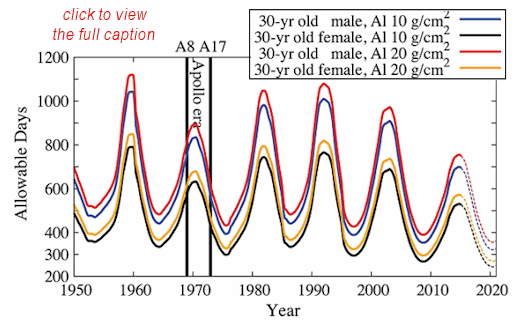Remarkably weak solar activity and intensifying cosmic rays preclude deep space human exploration?
_by_Carl_Drinkwater.jpg)
Dr. Tony Phillips, author of SpaceWeather.com, brought our attention to a very interesting research article published recently in AGU's journal "Space Weather". The article is titled "Does the worsening galactic cosmic radiation environment observed by CRaTER preclude future manned deep space exploration?" and its significance comes into play after NASA's successful test flight of Orion spacecraft on December 5 which heralds a renewed capability to send astronauts into deep space.
In the abstract of the paper authors remind that the Sun and its solar wind are currently exhibiting extremely low densities and magnetic field strengths, representing states that have never been observed during the space age.
"The highly abnormal solar activity between cycles 23 and 24 has caused the longest solar minimum in over 80 years and continues into the unusually small solar maximum of cycle 24. As a result of the remarkably weak solar activity, we have also observed the highest fluxes of galactic cosmic rays in the space age and relatively small solar energetic particle events. We use observations from the Cosmic Ray Telescope for the Effects of Radiation (CRaTER) on the Lunar Reconnaissance Orbiter to examine the implications of these highly unusual solar conditions for human space exploration."
The authors show that while these conditions are not a show stopper for long-duration missions (e.g., to the Moon, an asteroid, or Mars), galactic cosmic ray radiation remains a significant and worsening factor that limits mission durations.
The abstract continues… "While solar energetic particle events in cycle 24 present some hazard, the accumulated doses for astronauts behind 10 g/cm2 shielding are well below current dose limits. Galactic cosmic radiation presents a more significant challenge: the time to 3% risk of exposure-induced death (REID) in interplanetary space was less than 400 days for a 30 year old male and less than 300 days for a 30 year old female in the last cycle 23–24 minimum. The time to 3% REID is estimated to be ∼20% lower in the coming cycle 24–25 minimum.
If the heliospheric magnetic field continues to weaken over time, as is likely, then allowable mission durations will decrease correspondingly. Thus, we estimate exposures in extreme solar minimum conditions and the corresponding effects on allowable durations."
This figure from their paper shows the number of days a 30 year old astronaut can spend in interplanetary space before they reach their career limit in radiation exposure:
According to the plot, in the year 2014, a 30 year old male flying in a spaceship with 10 g/cm2 of aluminum shielding could spend approximately 700 days in deep space before they reach their radiation dose limit. The same astronaut in the early 1990s could have spent 1000 days in space. Image credit: N. A. Schwadron et. al. (AGU/Space Weather journal)
Dr. Phillips explains what's going on:
Cosmic rays are intensifying. Galactic cosmic rays are a mixture of high-energy photons and subatomic particles accelerated to near-light speed by violent events such as supernova explosions. Astronauts are protected from cosmic rays in part by the sun: solar magnetic fields and the solar wind combine to create a porous 'shield' that fends off energetic particles from outside the solar system.
The problem is that the sun and its solar wind are currently exhibiting extremely low densities and magnetic field strengths. As a result of this remarkably weak solar activity, the authors of the paper have also observed the highest fluxes of cosmic rays in the Space Age.
The shielding action of the sun is strongest during solar maximum and weakest during solar minimum – hence the 11-year rhythm of the mission duration plot. At the moment we are experiencing Solar Max, which should be a good time for astronauts to fly – but it's not a good time. The solar maximum of 2011 – 2014 is the weakest in a century, allowing unusual numbers of cosmic rays to penetrate the solar system.
This situation could become even worse if, as some researchers suspect, the sun is entering a long-term phase of the solar cycle characterized by relatively weak maxima and deep, extended minima. In such a future, feeble solar magnetic fields would do an extra-poor job keeping cosmic rays at bay, further reducing the number of days astronauts can travel far from Earth. – Dr. Tony Phillips (SpaceWeather.com)
References:
- "Does the worsening galactic cosmic radiation environment observed by CRaTER preclude future manned deep space exploration?" – N. A. Schwadron, J. B. Blake, A. W. Case, C. J. Joyce, J. Kasper, J. Mazur, N. Petro, M. Quinn, J. A. Porter, C. W. Smith, S. Smith, H. E. Spence, L. W. Townsend, R. Turner, J. K. Wilson, C. Zeitlin – Space Weather (AGU journal) – DOI: 10.1002/2014SW001084
- "Growing peril for astronauts?" by Dr. Tony Phillips (SpaceWeather.com)
Featured image: M42 – The Orion Nebula (II) by Carl Drinkwater (CC – via Flickr)


Commenting rules and guidelines
We value the thoughts and opinions of our readers and welcome healthy discussions on our website. In order to maintain a respectful and positive community, we ask that all commenters follow these rules.